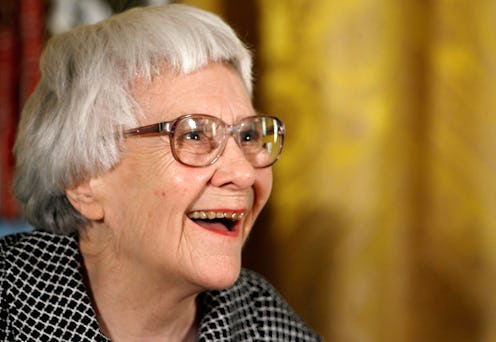News
Harper Lee Made Great Feminist Life Choices
The acclaimed author of To Kill a Mockingbird died at the age of 89 on Friday. Growing up in Alabama in the '20s and '30s, Harper Lee's feminist life choices highlight how she broke free of antiquated gender norms to live the life she wanted. Refusing to give interview for decades, Lee was an extremely private person, but her life choices and Pulitzer Prize-winning book established her legacy as a female role model.
Born Nelle Harper Lee in 1926, Lee spent much of her life in her hometown of Monroeville. To Kill a Mockingbird was centered around the racial and class issues surrounding Lee in the South, at a time when women faced a lot of oppression as well. Women didn't even gain the right to vote until Lee was 6 years old, so she was growing up as women were fighting for legal and political equality — a battle that isn't over yet, but has undoubtedly come a long way since Lee's childhood.
Her legendary book alone is full of feminist ideals that weren't super popular when it was published in 1960, including the main character, Scout, not adhering to traditionally female traits. To celebrate the iconic author's 89 years as an inspirational woman, here are some of Lee's most feminist choices:
Her Name
Deciding to drop her first name, Nelle, to go by Harper was a bold move. While it's not known why she chose to do so, Harper is much more ambiguous in terms of gender, and could easily denote a boy or girl. Her older sister, Alice Finch Lee, told The Guardian in 2012 that Lee grew up as "quite the little tomboy." Choosing to ditch her more feminine given name allowed Harper to dictate her own identity.
Her Hair
Similarly, the few public photos of Lee as a younger woman show her with a short haircut that those who believe in strict gender norms might classify as "boyish." Especially at a time when women were still under immense pressure to appear overly feminine, Lee's choice of haircut set her apart as a woman who made her own decisions about her life, including her appearance.
College
The author attended the all-female Huntingdon College in Montgomery, followed by University of Alabama at Tuscaloosa. Although she dropped out before completing her degree to pursue writing, Lee was focused on her studies while at school, not finding a husband. At her first college, she was a member of the literary honor society and wrote for the school newspaper and humor magazine at her second. Just attending college as a woman in the mid-1940s was a feminist statement, as male undergraduate students outnumbered female students more than two to one.
Moving To New York
Lee moved to New York by herself in 1949, when it wasn't very common for 23-year-old women to move to the big city alone — or do much of anything alone. She wasn't afraid to make a big move in order to chase her dream of becoming a writer, and it obviously paid off.
Single Life
Though Charles Shields book Mockingbird: A Portrait of Harper Lee claims she had a few love affairs in her day, she never married. Because Lee never spoke publicly about her personal life, it's impossible to know why she remained single — nevertheless, the decision definitely broke the mold for women of her generation.
Lee was a role model for women who put their career and themselves first, not letting social or gender norms influence her decisions.
